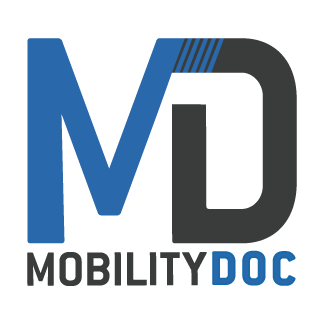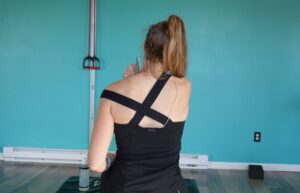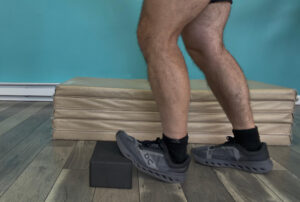As a physical therapy clinic with lots of active people, we’ve seen countless trends come and go in the world of recovery and rehabilitation. But one technique that has recently gotten a lot of attention is muscle scraping. This ancient practice, also known as Gua Sha or instrument-assisted soft tissue mobilization (IASTM), is making waves in the fitness and recovery world. In a previous blog we’ve talked about which instruments are right for you, but today we are sharing something special! Let’s break down the total protocol for muscle scraping so you can get the most benefits as you incorporate this great tool into your regular at home routine.
What is Muscle Scraping?
Muscle scraping (IASTM) is a manual technique in which you break up knots, adhesions, and scar tissue in the fascia. To give you a bit more of a visual, imagine a pile of shoe laces in a heaping twisted ball. That is what the connective tissue fibers look like when they have knots and adhesions. After about 30 mins, you untangle all of the shoe laces and lay them neatly in parallel lines. That is what healthy connective tissue looks like that allows you to contract and relax your muscles fully.
In order to break up those knots you use a tool to apply pressure to the skin and scrape back and forth. This scraping doesn’t just break up knots but it increases blood flow to the treated area, can reduce inflammation, and helps you recover faster!

Bringing the Therapy Home
While it’s always best to start with a professional, you can continue your muscle scraping journey at home. There are a few steps to this protocol so here’s a quick guide to get you started:
- Choose Your Tool: Invest in a quality muscle scraping tool. There are many options available, from traditional Gua Sha stones to modern stainless steel instruments. We always recommend using a steel tool. This will help you get tactile feedback into your hand on what parts need extra attention. Here is a link to Sidekick tools (our fave! This is an affiliate link)
- Warm Up: Before getting started it’s important to warm up with light exercise to get the area you’re about to work on prepped! Do a light jog, use a bike at a low intensity, or light resistance training for the upper body. You just want to initiate blood flow to the area.
- Muscle Scraping: Begin by using an emollient or lotion to help reduce friction. Then grab your tool and get scraping. You’ll work in 2 inch strokes around the entire area you’re looking to work on. Yes, we do mean the whole area! A common mistake is to focus only on where it’s hurting. Depending on how big of an area you’re working on you can spend anywhere from 3-15 minutes muscle scraping.
Pro Tip - Avoid bone!! You don’t want to muscle scrate directly onto bone (like the knee cap and elbow)
- Stretching: Now that we’ve broken up adhesions and knots in the connective tissue and fascia, it’s important to elongate the muscle and/or tendon. You can do both static and dynamic stretches to add length into the muscle.
- Strengthening: To tie this all together we want to teach our muscles how to move in a better way. By incorporating some strategic targeted strength exercises to the muscle we just worked on you can help re-teach it to move better. You don’t have to go crazy right away! Make sure you start light to see how your body reacts
Remember, muscle scraping takes practice to perfect your technique. Don’t be afraid to seek guidance from a professional to ensure you’re scraping safely and effectively.
When To Do This?
We suggest doing this 2-3 times a week as part of your regular warm up. This is a great way to prepare your body to do the activity you love to do. It is important not to do too much muscle scraping. Anything more than 15 minutes or the recommended 3 times per week has the potential to cause inflammation that can get out of hand. It’s always better to start conservatively and test what is and isn’t too much for your body.

Is Muscle Scraping Right for Me?
Whether you’re an athlete looking to boost performance, an office worker battling tension, or simply someone who wants to feel their best, muscle scraping could be the missing piece in your wellness puzzle. It’s a versatile, effective, and surprisingly enjoyable way to care for your body.
Muscle scraping isn’t for everyone though. If you’re have or are dealing with any of the following this might not be the best for you:
Deep Vein Thrombosis (DVT)
Varicosities
Pregnancy
Blood thinners
Infection (staph)
It’s always best to consult a doctor before trying anything new.
Watch Our Muscle Scraping Full Protocol Video Here:
Save This For Later!!
Don’t miss out on using the full protocol! Save this blog to your desktop, phone, whatever so you never forget which steps you need to take to get the most out of your muscle scraping. We’ve got an exciting knee video coming your way soon following the same game-changing format. Be the first to know when it drops by signing up for our email list!
Have any questions? Reach out to us on social media, and we’ll do our best to get back to you ASAP. Our team is here to support you every step of the way on your fitness journey.
Stay tuned for more mobility-boosting exercises and insider tips! Together, let’s unlock your full potential and take your performance to new heights.
Which Muscle Scraper is Right For You?
We love using Sidekick tools for muscle scraping due to their excellent quality and affordability. If you’re considering investing in a muscle scraping tool, check out the video above. The benefits of using a steel tool are significant; the tactile feedback acts like a roadmap, guiding you to areas needing extra attention—no other material offers this! Our top choice, used daily in our office, is the Sidekick Echo muscle scraper. It delivers professional-grade results similar to Graston tools but at a fraction of the price. Don’t just take our word for it—our patients rave about their effectiveness! If you have questions, feel free to reach out on our social media, and we’ll get back to you as soon as possible!
We love Sidekick so much we are affiliates. If you’d prefer not to use our link, that’s totally OK. Just know we stand behind their brand and strongly encourage you to look them up!





